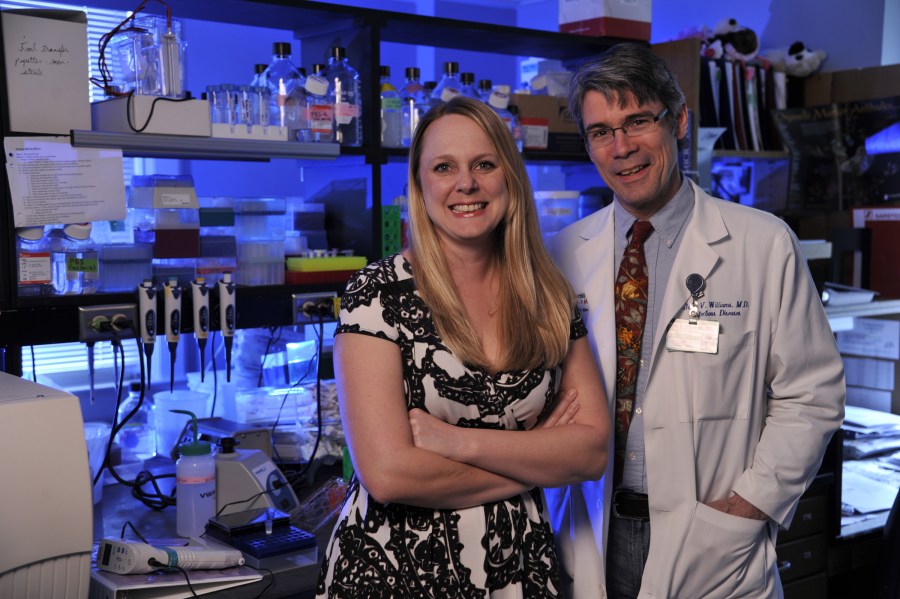
John Williams, M.D., Regan Cox and colleagues are studying a protein structure associated with two common respiratory diseases. (photo by John Russell)
Researchers spot Achilles’ heel in respiratory virus
A new viral protein structure could jump-start vaccine development for two leading causes of lower respiratory disease in children and elderly adults.
Vanderbilt University investigators, with collaborators at Stanford University, determined the structure of a protein from the human metapneumovirus (HMPV), together with an antibody that blocks the virus. Their findings, reported in the April issue of Nature Structural & Molecular Biology, identify a previously unrecognized region of an HMPV protein as a target for vaccine development.
The same region also appears in a related protein from respiratory syncytial virus (RSV), suggesting a new vaccine target for both viruses, said John Williams, M.D., associate professor of Pediatrics and of Pathology, Microbiology and Immunology at Vanderbilt.
RSV and HMPV are the two most common causes of serious respiratory illness in young children. The elderly too — particularly individuals with chronic lung disease — are vulnerable to the lower respiratory illnesses caused by RSV and HMPV. There is currently no licensed vaccine for either virus.
The two viruses fall into the family of paramyxoviruses, which also includes measles, mumps, parainfluenza viruses and emerging viruses such as Hendra and Nipah (the viral threat in the movie “Contagion”).
All of the paramyxovirus family members use a fusion (F) protein to fuse with host cells.
The F proteins are the major targets for vaccine-induced antibodies directed against these viruses, Williams said.
“The F protein is a critical protein for the virus to function; if you can block that protein, you can block the virus.”
Williams and his group had previously characterized antibodies against the HMPV F protein that effectively neutralized the virus in vitro and in animal models.
To discover where the antibodies interacted with the F protein — and provide a “view” of how they might be blocking the virus — Williams collaborated with James Crowe Jr., M.D., at Vanderbilt and Theodore Jardetzky, Ph.D., at Stanford.
The investigators used X-ray crystallography to determine the structure of the HMPV F protein interacting with the neutralizing antibody.
“We identified an epitope (the part of the F protein where the antibody binds) that nobody knew existed and that we wouldn’t have found any other way,” Williams said.
The novel epitope, which is present as a similar structure in RSV, “may be broadly conserved and represent a brand new target for all these different paramyxoviruses, not just for HMPV,” he added. “We’re calling it the Achilles’ heel of the protein.”
Having F protein structures is important for informing vaccine development, Williams stressed.
The HMPV F protein structure is only the fourth to be determined, and it is the first in combination with a neutralizing antibody.
“These are difficult viruses to make vaccines for, and we need a more rational approach,” he said. “Having structural information is really key to identifying vaccine targets in the virus.”
Williams and colleagues will now be synthesizing and testing the HMPV F protein epitope as a candidate vaccine.
They are also continuing structural studies of the F protein, particularly in combination with its host cellular receptor, to fully understand the F protein’s function.
The F protein has “one of the most dramatic conformational changes in nature,” Williams said. “It’s this incredible snapping open, snapping closed mechanism” that facilitates fusion of the virus with the cellular membrane.
Since some mammalian proteins work in a similar way, “how these fusion proteins do what they do” is of broad interest, he added.
Other Vanderbilt authors of the recent report include Jens Krause, M.D., and Reagan Cox. The research was supported by grants from the National Institute of Allergy and Infectious Diseases of the National Institutes of Health.













